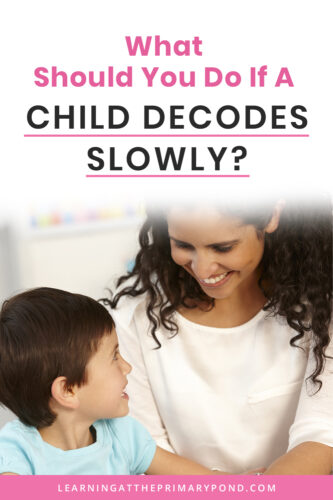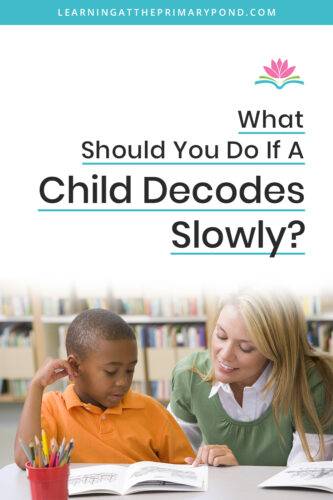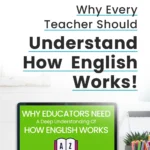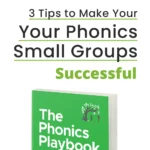If you teach students who are learning how to read, you probably see the reading process unfolding differently from child to child. Some of your students may be soaring with their decoding skills! And some of your students may be starting to get the hang of it, but their decoding is still very slow.
Decoding is the process of applying letter-sound and other phonics knowledge to read words. Decoding is the foundation of the reading process!
If students are having trouble decoding (or just decoding slowly), this can lead to frustration and problems down the road. For one, students’ reading fluency will be negatively impacted.
And if fluency is poor, comprehension will likely be impacted as well, because so much of students’ working memory will be devoted to just figuring out the words of the text. (If you want to read a bit more on fluency itself, check out this blog entitled “How To Build Fluency With K-2 Students.”)
Long story short, we want to make sure that students are solid in their decoding – and in doing so, we will be setting them up for future success with fluency and comprehension!
In this post, I have a video (and transcript, if you prefer to read) with tips so you can help students who decode at a slower pace.

Read the transcript here:
“Hey, I’m Alison from Learning At The Primary Pond. I’m a literacy specialist and in this video, I’m going to give you some tips to help a child who is decoding, but is decoding slowly and it’s kind of difficult for them. If you haven’t subscribed to my channel (https://www.youtube.com/@learningattheprimarypond) yet, make sure to do that now and then also hit the little bell so that you don’t miss any of the brand new videos I post about teaching literacy in K-2. So first let’s talk about why decoding speed matters. I know early on in my teaching career, I felt like, well, if they can get there, what does it matter what speed it’s at? But the issue is if a child is decoding slowly, so much of their working memory is devoted to just figuring out the words. Decoding is the process of taking letter-sound knowledge, phonics knowledge and reading words.
So if they’re decoding slowly, what happens is it can lead to frustration. They’re not able to get through a lot of text, or it takes them a really long time, but also fluency is impacted. So if you think about a child who’s decoding very slowly and it’s just kind of painstaking, then their reading fluency and reading speed is going to be a lot lower than a child who is decoding at a faster pace. When kids’ reading fluency is impacted, typically their comprehension is impacted as well. Think about a book that you’re just kind of struggling to get through. You probably don’t have this experience as an adult reader, but you’ve probably seen children have this experience where they’re just trying to figure out the words and they’re so focused on that, that their working memory, their attention, is not freed up to comprehend.
Now contrast that with the child who is able to decode a little bit more quickly, their fluency is better. Well, they’re not so focused on figuring out the words, therefore their working memory is available to do a little bit more with comprehension. So slow decoding, while it might not seem like a problem, can eventually become a problem if it’s impacting fluency and comprehension. Now, this is not to say that kids should not be slow when they’re decoding words when they’re just beginning to read. That is totally normal. We’re talking about kids who continue to struggle beyond that. So actually I have a question for you, have you ever worked with students who maybe their decoding knowledge or maybe their phonics knowledge was okay, but they were just decoding very slowly and then I would also love to know if you’ve had those types of students, have you tried anything? What have you done? So let me know in the comments if you’ve had kids like these and if you’ve tried anything that has worked well.
Let’s dive into what to do if a child is decoding slowly. The slow decoding could be for any number of reasons. We want to make sure that there’s a good base in phonics and phonological awareness knowledge that the child has, but there are also other factors, like maybe some kids just have processing speeds that are a little bit different, vision or visual processing issues could be interfering, maybe they’re just learning English as a second or third or fourth language, maybe it’s motivation, maybe they don’t feel confident in their reading and therefore they don’t want to read as much and so they don’t put a lot of energy into it. So slow decoding could really be for any number of reasons, but let’s talk about some things that can help.
First and foremost, we want to make sure that the phonics and phonological awareness, that quality systematic, explicit instruction is happening and then to kind of work on the decoding process some more. What I love to do is something called a blending drill. And there’s different ways to set this up, but essentially what you’ve got are letters on cards and you only put in letters and sounds that the kids have learned already. So you can do this with simple words, like CVC words, you can incorporate vowel teams and diphthongs, you can make this as easy or as difficult as the children’s knowledge allows. But basically what you do is eventually you’re pointing and the kids say, ‘Ch-a-t,’ and then they blend, ‘chat.’ And then you change one of the cards, ‘m-a-t, mat.’
Now for those kids that need a little bit of help, or when you’re first introducing this, you want to introduce it with the I do, we do, you do model. So if this were like… If we’re at that point with my students, I might say, ‘Okay, my turn. Listen. ch-a-t, chat. Now let’s do it together.’ And then all of us say, ‘ch-a-t, chat.’ Then I’ll say, ‘Your turn,’ and then they go, ‘ch-a-t, chat.’ And yes, that was the same word three times so I get that it’s a little repetitive, but some kids, especially if they’re struggling with decoding or they’re just starting out or even just learning how this works, that’s what’s needed, the I do, we do, you do. And eventually you just point like I did the first time and they say, ‘ch-a-t, chat.’ And you flip a card, ‘m-a-t, mat.’ It’s okay if you end up with nonsense words, because the point is to practice decoding, it’s a blending drill. So this is one way to help kids improve their decoding speed and it’s just repetition. You can do this a couple times a day, you can do it in whole group, you can do it in small group, but this drill does help a lot in building their decoding fluency.
Something else that is very simple, but really helps a lot with improving kids decoding and the pace at which they decode is just rereading. So if you’ve got a page of words that they’re reading with a given phonics pattern or whatever, have them read it two or three times. If they’re reading a text, especially decodable text, have them read it more than once and you can make it fun. Maybe they get to read with the tablet and they record it or maybe they get to read to a stuffed animal or maybe you incorporate some reader’s theater. But that rereading is really helpful, rereading the same text or the same words, is really helpful in building that fluency.
Another thing that you want to think about is it’s fine for kids to read word by word originally, but eventually you want to get to the point where they are kind of chunking and seeing parts of words because that can build fluency as well. So let’s say you’re working on maybe some initial blends with L and you’ve got a list of words, flag, and then let’s see, glad, and you got a list of words like this. And so the first time the children read the words, you can have them read like this, ‘f-l-a-g, flag.’ So sound by sound. ‘g-l-a-d, glad.’ But then have them go back a second time and have them kind of chunk it. So instead of reading sound by sound, this time we can actually keep these together and keep these together, so it’s like the onset and the rhyme. So this time, we read, ‘fl-ag, flag. gl-ad, glad.’ And then the third time we read it and you can actually have them physically underline if they have a list of words, you read, ‘flag, glad,’ and on down the list.
So you’re reading the same list three times, but it’s sound by sound, chunk by chunk and then word by word. So kind of goes along with rereading, but chunking is a great strategy that we want students to build as their decoding abilities and knowledge grows. And then last but not least fluent reading, we want to expose our students to fluent reading as much as possible. So teacher reading, your read alouds, maybe you’re having them on a free website like epic and they’re listening to stories, maybe they’re listening to a peer read who’s a little bit more fluent, maybe they’re reading along with a recording. All of those things build fluency and it’s a really good idea to incorporate some rereading in there so maybe they read something on their own first or maybe they read something with a recording first and then they read it on their own. But fluent reading, that modeling is so important.
I hope these tips were helpful to you. Again, let me know if you A) have worked with students who are a little bit slower with their decoding and then B) if you have any other great strategies to share. Of course, like I mentioned, phonics and phonological awareness is really that foundation of everything that you’re doing with decoding because if they don’t have the underlying phonics and phonological awareness skills, they can’t blend the sounds or they don’t know the sounds, then of course decoding is going to be difficult. So that’s our foundation. If you want to learn more about my phonics program From Sounds to Spelling (https://www.fromsoundstospelling.com/), which gives kids that really amazing foundation and also gets them decoding, there’s tons of helpful resources in there, lesson plans, it’s super teacher friendly. I’m going to include a link for that program below and of course, let me know if you have any questions. Thanks for watching. Again, I hope this was helpful. Don’t forget to hit the like button, subscribe (https://www.youtube.com/@learningattheprimarypond), and I will see you in the next video.”
Conclusion
I hope these tips were helpful to you! If you need a comprehensive phonics program that focuses on decoding and strategies for improving a child’s reading, check out From Sounds to Spelling.
This is a research-based phonics program that follows a systematic approach to teaching children to read. Here are some of the components included in the program:
- detailed lesson plans
- student materials
- differentiated resources
- visuals/posters
- professional development videos for teachers
If you want to try out a week of lesson plans for free, click here to start your free week now!
Happy teaching!













